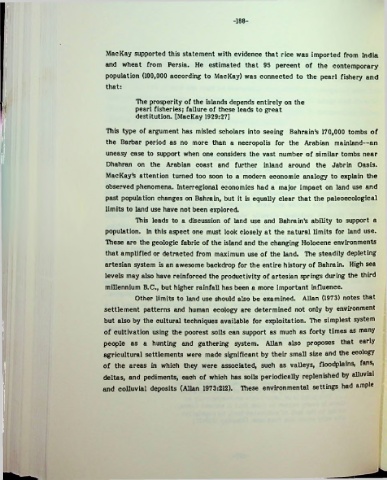Page 212 - Life & Land Use on the Bahrain Islands (Curtis E Larsen)
P. 212
-188-
MacKay supported this statement with evidence that rice was imported from India
and wheat from Persia. He estimated that 95 percent of the contemporary
population (100,000 according to MacKay) was connected to the pearl fishery and
that:
The prosperity of the islands depends entirely on the
pearl fisheries; failure of these leads to great
destitution. [MacKay 1929:27]
This type of argument has misled scholars into seeing Bahrain’s 170,000 tombs of
the Barbar period as no more than a necropolis for the Arabian mainland—an
uneasy case to support when one considers the vast number of similar tombs near
Dhahran on the Arabian coast and further inland around the Jabrin Oasis.
MacKay*s attention turned too soon to a modern economic analogy to explain the
observed phenomena. Interregional economics had a major impact on land use and
past population changes on Bahrain, but it is equally clear that the paleoecological
limits to land use have not been explored.
This leads to a discussion of land use and Bahrain’s ability to support a
population. In this aspect one must look closely at the natural limits for land use.
These are the geologic fabric of the island and the changing Holocene environments
that amplified or detracted from maximum use of the land. The steadily depleting
artesian system is an awesome backdrop for the entire history of Bahrain. High sea
levels may also have reinforced the productivity of artesian springs during the third
millennium B.C., but higher rainfall has been a more important influence.
Other limits to land use should also be examined. Allan (1973) notes that
settlement patterns and human ecology are determined not only by environment
but also by the cultural techniques available for exploitation. The simplest system
of cultivation using the poorest soils can support as much as forty times as many
people as a hunting and gathering system. Allan also proposes that early
agricultural settlements were made significant by their small size and the ecology
of the areas in which they were associated, such as valleys, floodplains, fans,
deltas, and pediments, each of which has soils periodically replenished by alluvial
and colluvial deposits (Allan 1973:212). These environmental settings had ample

